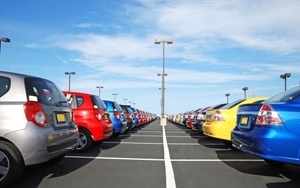 U.S. light-vehicle sales continued to weaken in February, compared with 2017, but remained relatively healthy overall, according to WardsAuto.
U.S. light-vehicle sales continued to weaken in February, compared with 2017, but remained relatively healthy overall, according to WardsAuto.
However, stiff new tariffs on steel and
aluminum imports announced Thursday by President Donald Trump would result in price increases likely to dampen the market further.
Trump declared his intention to set tariffs of 25% on
steel and 10% on aluminum.
"These proposed tariffs on steel and aluminum imports couldn't come at a worse time," said Cody Lusk, president of the American International Automobile
Dealers Association, in a statement. "Auto sales have flattened in recent months, and manufacturers are not prepared to absorb a sharp increase in the cost to build cars and trucks in
America."
advertisement
advertisement
Market softness spread beyond cars in February to other segments of the market, says Michelle Krebs, executive analyst for Autotrader.
“Trucks did not have a
spectacular month, despite some hefty incentives, and utility performance varied by brand,” Krebs said in a statement. “Still, January and February are low sales months. March and April
will truly indicate whether vehicle sales are ready to come out of hibernation.”
Meanwhile, the SUV landscape is getting more competitive, said Brian Moody, editorial director,
Autotrader.
“It’s no longer enough just to have SUVs and crossovers; they have to be good and new,” he says. “SUVs that are all-new or recently redesigned are [seeing]
sales increases – Jeep Wrangler, Buick Enclave, Chevy Traverse, Cadillac XT5, Nissan Rogue and Honda Pilot are doing well. This competition will only increase as off-lease SUVs start hitting the
market. Aging but well-known SUVs like the Ford Escape, Explorer, Flex, and Chevy Tahoe are trending down.”
With 2018 already forecast to see lower overall auto sales volume than 2017,
down months and variability are expected, says Stephanie Brinley, senior automotive analyst, IHS Markit.
“The impact of the recent tax changes has not quite filtered through to consumer
behavior,” Brinley said in written comments. “Consumers may be a bit on the fence, delaying a purchase as they evaluate the benefit of the changes to their income. The story relative to
slowing demand for cars and strong demand for utility vehicles continues to underlie results.”
This year is going to be a bitter but necessary pill for the auto industry to swallow, said
Jessica Caldwell, Edmunds executive director of industry analysis.
“Automakers are slowing production of passenger cars to react to declining demand, and are also trying to find
the right balance between keeping sales strong and becoming too dependent on costly incentives,” she says. “The industry is still in a fairly healthy place, but it may not feel like it,
since the last few years have been in record territory.”
While Presidents' Day weekend marked the first auto sales event of the year, Edmunds analysts say that automakers likely
didn’t pull out all the stops to get customers into the showrooms. The average incentive spend hit a record high of $3,400 in 2017, which is not a sustainable level, they say.
“In a down market, every sale is important, but this year automakers seem to be a bit more measured in how they’re using incentives,” Caldwell said. “Aggressive incentives
generally only pull forward existing demand, and automakers seem to be learning that you can only borrow so much from the future before you end up paying for it.